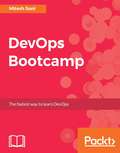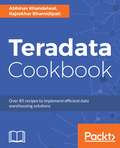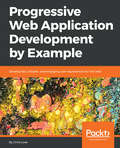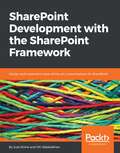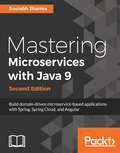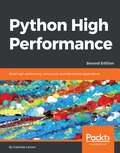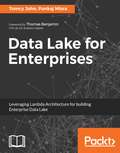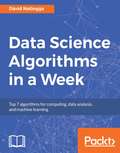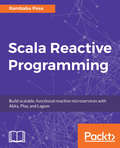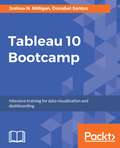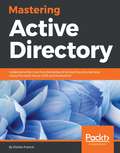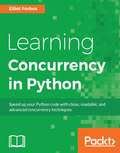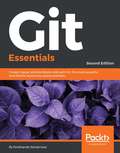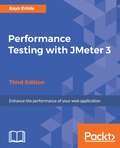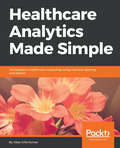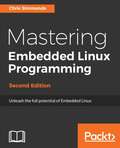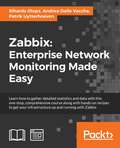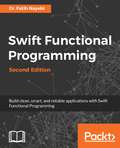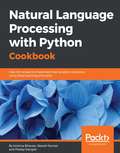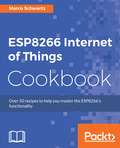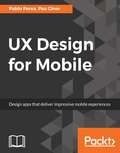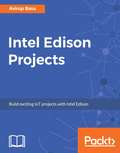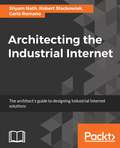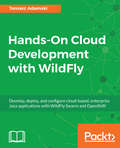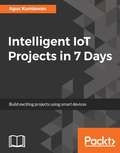- Table View
- List View
DevOps Bootcamp
by Mitesh SoniSharpen your DevOps knowledge with DevOps Bootcamp About This Book • Improve your organization's performance to ensure smooth production of software and services. • Learn how Continuous Integration and Continuous Delivery practices can be utilized to cultivate the DevOps culture. • A fast-paced guide filled with illustrations and best practices to help you consistently ship quality software. Who This Book Is For The book is aimed at IT Developers and Operations—administrators who want to quickly learn and implement the DevOps culture in their organization. What You Will Learn • Static Code Analysis using SOnarqube • Configure a Maven-based JEE Web Application • Perform Continuous Integration using Jenkins and VSTS • Install and configure Docker • Converge a Chef node using a Chef workstation • Accomplish Continuous Delivery in Microsoft Azure VM and Microsoft Azure App Services (Azure Web Apps) using Jenkins • Perform Load Testing using Apache JMeter • Build and Release Automation using Visual Studio Team Services • Monitor Cloud-based resources In Detail DevOps Bootcamp delivers practical learning modules in manageable chunks. Each chunk is delivered in a day, and each day is a productive one. Each day builds your competency in DevOps. You will be able to take the task you learn every day and apply it to cultivate the DevOps culture. Each chapter presents core concepts and key takeaways about a topic in DevOps and provides a series of hands-on exercises. You will not only learn the importance of basic concepts or practices of DevOps but also how to use different tools to automate application lifecycle management. We will start off by building the foundation of the DevOps concepts. On day two, we will perform Continuous Integration using Jenkins and VSTS both by configuring Maven-based JEE Web Application?. We will also integrate Jenkins and Sonar qube for Static Code Analysis. Further, on day three, we will focus on Docker containers where we will install and configure Docker and also create a Tomcat Container to deploy our Java based web application. On day four, we will create and configure the environment for application deployment in AWS and Microsoft Azure Cloud for which we will use Infrastructure as a Service and Open Source Configuration Management tool Chef. For day five, our focus would be on Continuous Delivery. We will automate application deployment in Docker container using Jenkins Plugin, AWS EC2 using Script, AWS Elastic Beanstalk using Jenkins Plugin, Microsoft Azure VM using script, and Microsoft Azure App Services Using Jenkins. We will also configure Continuous Delivery using VSTS. We will then learn the concept of Automated Testing on day six using Apache JMeter and URL-based tests in VSTS. Further, on day seven, we will explore various ways to automate application lifecycle management using orchestration. We will see how Pipeline can be created in Jenkins and VSTS, so the moment Continuous? Integration is completed successfully, Continuous Delivery will start and application will be deployed. On the final day, our focus would be on Security access to Jenkins and Monitoring of CI resources, and cloud-based resources in AWS and Microsoft Azure Platform as a Service. Style and Approach This book is all about fast and intensive learning. This means we don't waste time in helping readers get started. The new content is basically about filling in with highly-effective examples to build new things, solving problems in newer and unseen ways, and solving real-world examples.
Teradata Cookbook: Over 85 recipes to implement efficient data warehousing solutions
by Abhinav Khandelwal Rajsekhar BhamidipatiData management and analytics simplified with Teradata Key Features Take your understanding of Teradata to the next level and build efficient data warehousing applications for your organization Covers recipes on data handling, warehousing, advanced querying and the administrative tasks in Teradata. Contains practical solutions to tackle common (and not-so-common) problems you might encounter in your day to day activities Book Description Teradata is an enterprise software company that develops and sells its eponymous relational database management system (RDBMS), which is considered to be a leading data warehousing solutions and provides data management solutions for analytics. This book will help you get all the practical information you need for the creation and implementation of your data warehousing solution using Teradata. The book begins with recipes on quickly setting up a development environment so you can work with different types of data structuring and manipulation function. You will tackle all problems related to efficient querying, stored procedure searching, and navigation techniques. Additionally, you’ll master various administrative tasks such as user and security management, workload management, high availability, performance tuning, and monitoring. This book is designed to take you through the best practices of performing the real daily tasks of a Teradata DBA, and will help you tackle any problem you might encounter in the process. What you will learn Understand Teradata's competitive advantage over other RDBMSs. Use SQL to process data stored in Teradata tables. Leverage Teradata’s available application utilities and parallelism to play with large datasets Apply various performance tuning techniques to optimize the queries. Acquire deeper knowledge and understanding of the Teradata Architecture. Easy steps to load, archive, restore data and implement Teradata protection features Gain confidence in running a wide variety of Data analytics and develop applications for the Teradata environment Who this book is for This book is for Database administrator's and Teradata users who are looking for a practical, one-stop resource to solve all their problems while handling their Teradata solution. If you are looking to learn the basic as well as the advanced tasks involved in Teradata querying or administration, this book will be handy. Some knowledge of relational database concepts will be helpful to get the best out of this book.
Progressive Web Application Development by Example: Develop fast, reliable, and engaging user experiences for the web
by Chris LoveLeverage the full potential of the web to make your web sites better than native applications for every platform. Key FeaturesExplore different models and patterns required to develop progressive web applicationsCreate applications requiring shorter runtime for attracting more usersStudy different projects to understand the fundamentals of progressive web applicationsBook DescriptionAre you a developer that wants to create truly cross-platform user experiences with a minimal footprint, free of store restrictions and features customers want? Then you need to get to grips with Progressive Web Applications (PWAs), a perfect amalgamation of web and mobile applications with a blazing-fast response time.Progressive Web Application Development by Example helps you explore concepts of the PWA development by enabling you to develop three projects, starting with a 2048 game. In this game, you will review parts of a web manifest file and understand how a browser uses properties to define the home screen experience. You will then move on to learning how to develop and use a podcast client and be introduced to service workers. The application will demonstrate how service workers are registered and updated. In addition to this, you will review a caching API so that you have a firm understanding of how to use the cache within a service worker, and you'll discover core caching strategies and how to code them within a service worker.Finally, you will study how to build a tickets application, wherein you’ll apply advanced service worker techniques, such as cache invalidation. Also, you'll learn about tools you can use to validate your applications and scaffold them for quality and consistency. By the end of the book, you will have walked through browser developer tools, node modules, and online tools for creating high-quality PWAs.What you will learnExplore the core principles of PWAs Study the three main technical requirements of PWAs Discover enhancing requirements to make PWAs transcend native apps and traditional websites Create and install PWAs on common websites with a given HTTPS as the core requirementGet acquainted with the service worker life cycle Define service worker caching patternsApply caching strategies to three different website scenariosImplement best practices for web performanceWho this book is forProgressive Web Application Development by Example is for you if you’re a web developer or front-end designer who wants to ensure improved user experiences. If you are an application developer with knowledge of HTML, CSS, and JavaScript, this book will help you enhance your skills in order to develop progressive web applications, the future of app development.
SharePoint Development with the SharePoint Framework
by Jussi Roine Olli JaaskelainenDesign and create beautiful solutions using modern development tools for SharePoint Online About This Book • Get the best out of the latest Sharepoint Framework and leverage the Sharepoint RESTful and JSOM APIs. • Develop efficient client side applications with JavaScript injection and Sharepoint Addins. • Get the best tips and tricks on designing your website flawlessly. Who This Book Is For This book targets current SharePoint developers, as well as people starting their journey on SharePoint development. The reader must have basic web development programming knowledge, including JavaScript and CSS. The reader should have familiarity using and managing SharePoint-based collaboration sites. What You Will Learn • Understand what the SharePoint Framework is • Create modern solutions using the new tools, approaches and frameworks • Learn how to use Visual Studio Code for effective SharePoint development • Package and deploy your code, using automation as needed • Work with content and data stored in SharePoint • Benefit from third party frameworks without having to build your own frameworks • Debug and troubleshoot your code with ease • Configure security in your application In Detail SharePoint is one of Microsoft's best known web platforms. A loyal audience of developers, IT Pros and power users use it to build line of business solutions. The SharePoint Framework (SPFx) is a great new option for developing SharePoint solutions. Many developers are creating full-trust based solutions or add-in solutions, while also figuring out where and how SPFx fits in the big picture. This book shows you how design, build, deploy and manage SPFx based solutions for SharePoint Online and SharePoint 2016. The book starts by getting you familiar with the basic capabilities of SPFx. After that, we will walk through the tool-chain on how to best create production-ready solutions that can be easily deployed manually or fully automated throughout your target Office 365 tenants. We describe how to configure and use Visual Studio Code, the de facto development environment for SPFx-based solutions. Next, we provide guidance and a solid approach to packaging and deploying your code. We also present a straightforward approach to troubleshooting and debugging your code an environment where business applications run on the client side instead of the server side. Style and approach The approach will be that of a practical tutorial which will take you through every topic using code samples and working examples.
Mastering Microservices with Java 9 - Second Edition
by Sourabh SharmaMaster the art of implementing scalable microservices in your production environment with ease About This Book • Use domain-driven design to build microservices • Use Spring Cloud to use Service Discovery and Registeration • Use Kafka, Avro and Spring Streams for implementing event based microservices Who This Book Is For This book is for Java developers who are familiar with the microservices architecture and now wants to take a deeper dive into effectively implementing microservices at an enterprise level. A reasonable knowledge level and understanding of core microservice elements and applications is expected. What You Will Learn • Use domain-driven design to design and implement microservices • Secure microservices using Spring Security • Learn to develop REST service development • Deploy and test microservices • Troubleshoot and debug the issues faced during development • Learning best practices and common principals about microservices In Detail Microservices are the next big thing in designing scalable, easy-to-maintain applications. It not only makes app development easier, but also offers great flexibility to utilize various resources optimally. If you want to build an enterprise-ready implementation of the microservices architecture, then this is the book for you! Starting off by understanding the core concepts and framework, you will then focus on the high-level design of large software projects. You will gradually move on to setting up the development environment and configuring it before implementing continuous integration to deploy your microservice architecture. Using Spring security, you will secure microservices and test them effectively using REST Java clients and other tools like RxJava 2.0. We'll show you the best patterns, practices and common principals of microservice design and you'll learn to troubleshoot and debug the issues faced during development. We'll show you how to design and implement reactive microservices. Finally, we'll show you how to migrate a monolithic application to microservices based application. By the end of the book, you will know how to build smaller, lighter, and faster services that can be implemented easily in a production environment. Style and approach This book starts from the basics, including environment setup and provides easy-to-follow steps to implement the sample project using microservices.
Python High Performance - Second Edition
by Gabriele LanaroLearn how to use Python to create efficient applications About This Book • Identify the bottlenecks in your applications and solve them using the best profiling techniques • Write efficient numerical code in NumPy, Cython, and Pandas • Adapt your programs to run on multiple processors and machines with parallel programming Who This Book Is For The book is aimed at Python developers who want to improve the performance of their application. Basic knowledge of Python is expected What You Will Learn • Write efficient numerical code with the NumPy and Pandas libraries • Use Cython and Numba to achieve native performance • Find bottlenecks in your Python code using profilers • Write asynchronous code using Asyncio and RxPy • Use Tensorflow and Theano for automatic parallelism in Python • Set up and run distributed algorithms on a cluster using Dask and PySpark In Detail Python is a versatile language that has found applications in many industries. The clean syntax, rich standard library, and vast selection of third-party libraries make Python a wildly popular language. Python High Performance is a practical guide that shows how to leverage the power of both native and third-party Python libraries to build robust applications. The book explains how to use various profilers to find performance bottlenecks and apply the correct algorithm to fix them. The reader will learn how to effectively use NumPy and Cython to speed up numerical code. The book explains concepts of concurrent programming and how to implement robust and responsive applications using Reactive programming. Readers will learn how to write code for parallel architectures using Tensorflow and Theano, and use a cluster of computers for large-scale computations using technologies such as Dask and PySpark. By the end of the book, readers will have learned to achieve performance and scale from their Python applications. Style and approach A step-by-step practical guide filled with real-world use cases and examples
Data Lake for Enterprises
by Tomcy John Pankaj MisraA practical guide to implementing your enterprise data lake using Lambda Architecture as the base About This Book • Build a full-fledged data lake for your organization with popular big data technologies using the Lambda architecture as the base • Delve into the big data technologies required to meet modern day business strategies • A highly practical guide to implementing enterprise data lakes with lots of examples and real-world use-cases Who This Book Is For Java developers and architects who would like to implement a data lake for their enterprise will find this book useful. If you want to get hands-on experience with the Lambda Architecture and big data technologies by implementing a practical solution using these technologies, this book will also help you. What You Will Learn • Build an enterprise-level data lake using the relevant big data technologies • Understand the core of the Lambda architecture and how to apply it in an enterprise • Learn the technical details around Sqoop and its functionalities • Integrate Kafka with Hadoop components to acquire enterprise data • Use flume with streaming technologies for stream-based processing • Understand stream- based processing with reference to Apache Spark Streaming • Incorporate Hadoop components and know the advantages they provide for enterprise data lakes • Build fast, streaming, and high-performance applications using ElasticSearch • Make your data ingestion process consistent across various data formats with configurability • Process your data to derive intelligence using machine learning algorithms In Detail The term "Data Lake" has recently emerged as a prominent term in the big data industry. Data scientists can make use of it in deriving meaningful insights that can be used by businesses to redefine or transform the way they operate. Lambda architecture is also emerging as one of the very eminent patterns in the big data landscape, as it not only helps to derive useful information from historical data but also correlates real-time data to enable business to take critical decisions. This book tries to bring these two important aspects — data lake and lambda architecture—together. This book is divided into three main sections. The first introduces you to the concept of data lakes, the importance of data lakes in enterprises, and getting you up-to-speed with the Lambda architecture. The second section delves into the principal components of building a data lake using the Lambda architecture. It introduces you to popular big data technologies such as Apache Hadoop, Spark, Sqoop, Flume, and ElasticSearch. The third section is a highly practical demonstration of putting it all together, and shows you how an enterprise data lake can be implemented, along with several real-world use-cases. It also shows you how other peripheral components can be added to the lake to make it more efficient. By the end of this book, you will be able to choose the right big data technologies using the lambda architectural patterns to build your enterprise data lake. Style and approach The book takes a pragmatic approach, showing ways to leverage big data technologies and lambda architecture to build an enterprise-level data lake.
Data Science Algorithms in a Week
by David NatinggaBuild strong foundation of machine learning algorithms In 7 days. About This Book • Get to know seven algorithms for your data science needs in this concise, insightful guide • Ensure you're confident in the basics by learning when and where to use various data science algorithms • Learn to use machine learning algorithms in a period of just 7 days Who This Book Is For This book is for aspiring data science professionals who are familiar with Python and have a statistics background. It is ideal for developers who are currently implementing one or two data science algorithms and want to learn more to expand their skill set. What You Will Learn • Find out how to classify using Naive Bayes, Decision Trees, and Random Forest to achieve accuracy to solve complex problems • Identify a data science problem correctly and devise an appropriate prediction solution using Regression and Time-series • See how to cluster data using the k-Means algorithm • Get to know how to implement the algorithms efficiently in the Python and R languages In Detail Machine learning applications are highly automated and self-modifying, and they continue to improve over time with minimal human intervention as they learn with more data. To address the complex nature of various real-world data problems, specialized machine learning algorithms have been developed that solve these problems perfectly. Data science helps you gain new knowledge from existing data through algorithmic and statistical analysis. This book will address the problems related to accurate and efficient data classification and prediction. Over the course of 7 days, you will be introduced to seven algorithms, along with exercises that will help you learn different aspects of machine learning. You will see how to pre-cluster your data to optimize and classify it for large datasets. You will then find out how to predict data based on the existing trends in your datasets. This book covers algorithms such as: k-Nearest Neighbors, Naive Bayes, Decision Trees, Random Forest, k-Means, Regression, and Time-series. On completion of the book, you will understand which machine learning algorithm to pick for clustering, classification, or regression and which is best suited for your problem. Style and approach Machine learning applications are highly automated and self-modifying which continue to improve over time with minimal human intervention as they learn with more data. To address the complex nature of various real world data problems, specialized machine learning algorithms have been developed that solve these problems perfectly.
Scala Reactive Programming: Build scalable, functional reactive microservices with Akka, Play, and Lagom
by Rambabu PosaBuild fault-tolerant, robust, and distributed applications in Scala Key Features - Understand and use the concepts of reactive programming to build distributed systems running on multiple nodes. - Learn how reactive architecture reduces complexity throughout the development process. - Get to grips with functional reactive programming and Reactive Microservices. Book Description Reactive programming is a scalable, fast way to build applications, and one that helps us write code that is concise, clear, and readable. It can be used for many purposes such as GUIs, robotics, music, and others, and is central to many concurrent systems. This book will be your guide to getting started with Reactive programming in Scala. You will begin with the fundamental concepts of Reactive programming and gradually move on to working with asynchronous data streams. You will then start building an application using Akka Actors and extend it using the Play framework. You will also learn about reactive stream specifications, event sourcing techniques, and different methods to integrate Akka Streams into the Play Framework. This book will also take you one step forward by showing you the advantages of the Lagom framework while working with reactive microservices. You will also learn to scale applications using multi-node clusters and test, secure, and deploy your microservices to the cloud. By the end of the book, you will have gained the knowledge to build robust and distributed systems with Scala and Akka. What you will learn Understand the fundamental principles of Reactive and Functional programming Develop applications utilizing features of the Akka framework Explore techniques to integrate Scala, Akka, and Play together Learn about Reactive Streams with real-time use cases Develop Reactive Web Applications with Play, Scala, Akka, and Akka Streams Develop and deploy Reactive microservices using the Lagom framework and ConductR Who this book is for This book is for Scala developers who would like to build fault-tolerant, scalable distributed systems. No knowledge of Reactive programming is required.
Tableau 10 Bootcamp
by Joshua N. Milligan Donabel SantosSharpen your data visualization skills with Tableau 10 Bootcamp. About This Book • Make informed decisions using powerful visualizations in Tableau • Learn effective data storytelling to transform how your business uses ideas • Use this extensive bootcamp that makes you an efficient Tableau user in a short span of time Who This Book Is For This book caters to business, data, and analytics professionals who want to build rich interactive visualizations using Tableau Desktop. Familiarity with previous versions of Tableau will be helpful, but not necessary. What You Will Learn • Complete practical Tableau tasks with each chapter • Build different types of charts in Tableau with ease • Extend data using calculated fields and parameters • Prepare and refine data for analysis • Create engaging and interactive dashboards • Present data effectively using story points In Detail Tableau is a leading visual analytics software that can uncover insights for better and smarter decision making. Tableau has an uncanny ability to beautify your data, compared to other BI tools, which makes it an ideal choice for performing fast and easy visual analysis. Tableau 10 Bootcamp delivers practical learning modules in manageable chunks. Each chunk is delivered in a “day” and each “day” is a productive day. Each day builds your competency in Tableau. You will increase your competency in integrating analytics and forecasting to enhance data analysis during the course of this bootcamp. Each chapter presents core concepts and key takeaways about a topic in Tableau and provides a series of hands-on exercises. In addition to these exercises, at the end of the chapter, you will find self-check quizzes and extra drills to challenge you, to take what you learned to the next level. To summarize, this book will equip you with step-by-step instructions through rigorous tasks, practical callouts, and various real-world examples and assignments to reinforce your understanding of Tableau 10. Style and approach A fast paced book filled with highly-effective real-world examples to help you build new things and help you in solving problems in newer and unseen ways.
Mastering Active Directory: Deploy And Secure Infrastructures With Active Directory, Windows Server 2016, And Powershell, 2nd Edition
by Dishan FrancisBecome a master at managing enterprise identity infrastructure by leveraging Active Directory About This Book • Manage your Active Directory services for Windows Server 2016 effectively • Automate administrative tasks in Active Directory using PowerShell • Manage your organization's network with ease Who This Book Is For If you are an Active Directory administrator, system administrator, or network professional who has basic knowledge of Active Directory and are looking to gain expertise in this topic, this is the book for you. What You Will Learn • Explore the new features in Active Directory Domain Service 2016 • Automate AD tasks with PowerShell • Get to know the advanced functionalities of the schema • Learn about Flexible Single Master Operation (FSMO) roles and their placement • Install and migrate Active directory from older versions to Active Directory 2016 • Manage Active Directory objects using different tools and techniques • Manage users, groups, and devices effectively • Design your OU structure in the best way • Audit and monitor Active Directory • Integrate Azure with Active Directory for a hybrid setup In Detail Active Directory is a centralized and standardized system that automates networked management of user data, security, and distributed resources and enables interoperation with other directories. If you are aware of Active Directory basics and want to gain expertise in it, this book is perfect for you. We will quickly go through the architecture and fundamentals of Active Directory and then dive deep into the core components, such as forests, domains, sites, trust relationships, OU, objects, attributes, DNS, and replication. We will then move on to AD schemas, global catalogs, LDAP, RODC, RMS, certificate authorities, group policies, and security best practices, which will help you gain a better understanding of objects and components and how they can be used effectively. We will also cover AD Domain Services and Federation Services for Windows Server 2016 and all their new features. Last but not least, you will learn how to manage your identity infrastructure for a hybrid-cloud setup. All this will help you design, plan, deploy, manage operations on, and troubleshoot your enterprise identity infrastructure in a secure, effective manner. Furthermore, I will guide you through automating administrative tasks using PowerShell cmdlets. Toward the end of the book, we will cover best practices and troubleshooting techniques that can be used to improve security and performance in an identity infrastructure. Style and approach This step-by-step guide will help you master the core functionalities of Active Directory services using Microsoft Server 2016 and PowerShell, with real-world best practices at the end.
Learning Concurrency in Python
by Elliot ForbesPractically and deeply understand concurrency in Python to write efficient programs About This Book • Build highly efficient, robust, and concurrent applications • Work through practical examples that will help you address the challenges of writing concurrent code • Improve the overall speed of execution in multiprocessor and multicore systems and keep them highly available Who This Book Is For This book is for Python developers who would like to get started with concurrent programming. Readers are expected to have a working knowledge of the Python language, as this book will build on these fundamentals concepts. What You Will Learn • Explore the concept of threading and multiprocessing in Python • Understand concurrency with threads • Manage exceptions in child threads • Handle the hardest part in a concurrent system — shared resources • Build concurrent systems with Communicating Sequential Processes (CSP) • Maintain all concurrent systems and master them • Apply reactive programming to build concurrent systems • Use GPU to solve specific problems In Detail Python is a very high level, general purpose language that is utilized heavily in fields such as data science and research, as well as being one of the top choices for general purpose programming for programmers around the world. It features a wide number of powerful, high and low-level libraries and frameworks that complement its delightful syntax and enable Python programmers to create. This book introduces some of the most popular libraries and frameworks and goes in-depth into how you can leverage these libraries for your own high-concurrent, highly-performant Python programs. We'll cover the fundamental concepts of concurrency needed to be able to write your own concurrent and parallel software systems in Python. The book will guide you down the path to mastering Python concurrency, giving you all the necessary hardware and theoretical knowledge. We'll cover concepts such as debugging and exception handling as well as some of the most popular libraries and frameworks that allow you to create event-driven and reactive systems. By the end of the book, you'll have learned the techniques to write incredibly efficient concurrent systems that follow best practices. Style and approach This easy-to-follow guide teaches you new practices and techniques to optimize your code, and then moves toward more advanced ways to effectively write efficient Python code. Small and simple practical examples will help you test the concepts yourself, and you will be able to easily adapt them for any application.
Git Essentials - Second Edition: Create, merge, and distribute code with Git, the most powerful and flexible versioning system available
by Ferdinando SantacroceDive and explore into the latest addons of the latest Git. About This Book • Master all the basic concepts of Git to protect your code and make it easier to evolve • Use Git proficiently, and learn how to resolve day-by-day challenges easily • This step-by-step guide is packed with examples to help you learn and work with Git's internals Who This Book Is For If you are a software developer with little or no experience of versioning systems, or you are familiar with other centralized versioning systems, then this book is for you. If you have experience in server and system management and need to broaden your use of Git from a DevOps perspective, this book contains everything you need. What You Will Learn • Master Git fundamentals • Be able to "visualize," even with the help of a valid GUI tool • Write principal commands in a shell • Figure out the right strategy to run change your daily work with few or no annoyances • Explore the tools used to migrate to Git from the Subversion versioning system without losing your development history • Plan new projects and repositories with ease, using online services, or local network resources In Detail Since its inception, Git has attracted skilled developers due to its robust, powerful, and reliable features. Its incredibly fast branching ability transformed a piece of code from a niche tool for Linux Kernel developers into a mainstream distributed versioning system. Like most powerful tools, Git can be hard to approach since it has a lot of commands, subcommands, and options that easily confuse newcomers. The 2nd edition of this very successful book will help you overcome this fear and become adept in all the basic tasks in Git. Building upon the success of the first book, we start with a brief step-by-step installation guide; after this, you'll delve into the essentials of Git. For those of you who have bought the first edition, this time we go into internals in far greater depth, talking less about theory and using much more practical examples. The book serves as a primer for topics to follow, such as branching and merging, creating and managing a GitHub personal repository, and fork and pull requests. You'll then learn the art of cherry-picking, taking only the commits you want, followed by Git blame. Finally, we'll see how to interoperate with a Subversion server, covering the concepts and commands needed to convert an SVN repository into a Git repository. To conclude, this is a collection of resources, links, and appendices to satisfy even the most curious. Style and approach This short guide will help you understand the concepts and fundamentals of GIT is a step-by-step manner.
Performance Testing with JMeter 3 - Third Edition
by Bayo ErinleA practical guide to help you undertand the ability of Apache jMeter to load and performance test various server types in a more efficient way. About This Book • Use jMeter to create and run tests to improve the performance of your webpages and applications • Learn to build a test plan for your websites and analyze the results • Unleash the power of various features and changes introduced in Apache jMeter 3.0 Who This Book Is For This book is for software professionals who want to understand and improve the performance of their applications with Apache jMeter. What You Will Learn • See why performance testing is necessary and learn how to set up JMeter • Record and test with JMeter • Handle various form inputs in JMeter and parse results during testing • Manage user sessions in web applications in the context of a JMeter test • Monitor JMeter results in real time • Perform distributed testing with JMeter • Get acquainted with helpful tips and best practices for working with JMeter In Detail JMeter is a Java application designed to load and test performance for web application. JMeter extends to improve the functioning of various other static and dynamic resources. This book is a great starting point to learn about JMeter. It covers the new features introduced with JMeter 3 and enables you to dive deep into the new techniques needed for measuring your website performance. The book starts with the basics of performance testing and guides you through recording your first test scenario, before diving deeper into JMeter. You will also learn how to configure JMeter and browsers to help record test plans. Moving on, you will learn how to capture form submission in JMeter, dive into managing sessions with JMeter and see how to leverage some of the components provided by JMeter to handle web application HTTP sessions. You will also learn how JMeter can help monitor tests in real-time. Further, you will go in depth into distributed testing and see how to leverage the capabilities of JMeter to accomplish this. You will get acquainted with some tips and best practices with regard to performance testing. By the end of the book, you will have learned how to take full advantage of the real power behind Apache JMeter. Style and approach The book is a practical guide starting with introducing the readers to the importance of automated testing. It will then be a beginner's journey from getting introduced to Apache jMeter to an in-detail discussion of more advanced features and possibilities with it.
Healthcare Analytics Made Simple: Techniques in healthcare computing using machine learning and Python
by Vikas Vik KumarAdd a touch of data analytics to your healthcare systems and get insightful outcomesKey FeaturesPerform healthcare analytics with Python and SQLBuild predictive models on real healthcare data with pandas and scikit-learnUse analytics to improve healthcare performanceBook DescriptionIn recent years, machine learning technologies and analytics have been widely utilized across the healthcare sector. Healthcare Analytics Made Simple bridges the gap between practising doctors and data scientists. It equips the data scientists’ work with healthcare data and allows them to gain better insight from this data in order to improve healthcare outcomes.This book is a complete overview of machine learning for healthcare analytics, briefly describing the current healthcare landscape, machine learning algorithms, and Python and SQL programming languages. The step-by-step instructions teach you how to obtain real healthcare data and perform descriptive, predictive, and prescriptive analytics using popular Python packages such as pandas and scikit-learn. The latest research results in disease detection and healthcare image analysis are reviewed.By the end of this book, you will understand how to use Python for healthcare data analysis, how to import, collect, clean, and refine data from electronic health record (EHR) surveys, and how to make predictive models with this data through real-world algorithms and code examples.What you will learnGain valuable insight into healthcare incentives, finances, and legislation Discover the connection between machine learning and healthcare processesUse SQL and Python to analyze dataMeasure healthcare quality and provider performanceIdentify features and attributes to build successful healthcare models Build predictive models using real-world healthcare dataBecome an expert in predictive modeling with structured clinical dataSee what lies ahead for healthcare analyticsWho this book is forHealthcare Analytics Made Simple is for you if you are a developer who has a working knowledge of Python or a related programming language, although you are new to healthcare or predictive modeling with healthcare data. Clinicians interested in analytics and healthcare computing will also benefit from this book. This book can also serve as a textbook for students enrolled in an introductory course on machine learning for healthcare.
Mastering Embedded Linux Programming – Second Edition
by Chris SimmondsLinux is a highly-respected open source operating system that can scale from small devices to large supercomputers. This book describes how to employ Linux at the bottom end of the scale to create efficient, secure, and cost-effective products.
Zabbix: Enterprise Network Montioring Made Easy
by Andrea Dalle Vacche Patrik Uytterhoeven Rihards OlupsLearn how to gather detailed statistics and data with this one-stop, comprehensive course along with hands-on recipes to get your infrastructure up and running with Zabbix. About This Book • Monitor your network and deploy impressive business solutions with Zabbix • Get practical recipes to automate your Zabbix infrastructure and create impressive graphs • Integrate, customize, and extend your monitoring solutions with external components and software. Who This Book Is For This course is for System Administrators who have been managing and monitoring infrastructure. You do not need any knowledge about Zabbix. What You Will Learn • Efficiently collect data from a large variety of monitoring objects • Organize your data in graphs, charts, maps, and slide shows • Write your own custom probes and monitoring scripts to extend Zabbix • Configure Zabbix and its database to be high available and fault-tolerant • Automate repetitive procedures using Zabbix's API • FInd out how to monitor SNMP devices • Manage hosts, users, and permissions while acting upon monitored conditions • Set up your Zabbix infrastructure efficiently • Customize the Zabbix interface to suit your system needs • Monitor your VMware infrastructure in a quick and easy way with Zabbix In Detail Nowadays, monitoring systems play a crucial role in any IT environment. They are extensively used to not only measure your system's performance, but also to forecast capacity issues. This is where Zabbix, one of the most popular monitoring solutions for networks and applications, comes into the picture. With an efficient monitoring system in place, you'll be able to foresee when your infrastructure runs under capacity and react accordingly. Due to the critical role a monitoring system plays, it is fundamental to implement it in the best way from its initial setup. This avoids misleading, confusing, or, even worse, false alarms that can disrupt an efficient and healthy IT department. This course is for administrators who are looking for an end-to-end monitoring solution. It will get you accustomed with the powerful monitoring solution, starting with installation and explaining the fundamentals of Zabbix. Moving on, we explore the complex functionalities of Zabbix in the form of enticing recipes. These recipes will help you to gain control of your infrastructure. You will be able to organize your data in the form of graphs and charts along with building intelligent triggers for monitoring your network proactively. Toward the end, you will gain expertise in monitoring your networks and applications using Zabbix. This Learning Path combines some of the best that Packt has to offer in one complete, curated package. It includes content from the following Packt products: • Zabbix Network Monitoring-Second Edition • Zabbix Cookbook • Mastering Zabbix-Second Edition Style and approach This course is a compact practical guide that starts from the fundamentals of Zabbix and takes you all the way to building a monitoring solution that gathers data from a large variety of systems. Along the way, we will discuss the low-level operational details that should benefit you even if you have used Zabbix for a while. It also follows a step-by-step approach that is easy to follow, full of engaging examples, and will help you apply the theory to practice.
Swift Functional Programming - Second Edition
by Fatih NayebiBring the power of functional programming to Swift to develop clean, smart, scalable and reliable applications. About This Book • Written for the latest version of Swift, this is a comprehensive guide that introduces iOS, Web and macOS developers to the all-new world of functional programming that has so far been alien to them • Get familiar with using functional programming alongside existing OOP techniques so you can get the best of both worlds and develop clean, robust, and scalable code • Develop a case study on example backend API with Swift and Vapor Framework and an iOS application with Functional Programming, Protocol-Oriented Programming, Functional Reactive Programming, and Object-Oriented Programming techniques Who This Book Is For Meant for a reader who knows object-oriented programming, has some experience with Objective-C/Swift programming languages and wants to further enhance his skills with functional programming techniques with Swift 3.x. What You Will Learn • Understand what functional programming is and why it matters • Understand custom operators, function composition, currying, recursion, and memoization • Explore algebraic data types, pattern matching, generics, associated type protocols, and type erasure • Get acquainted with higher-kinded types and higher-order functions using practical examples • Get familiar with functional and non-functional ways to deal with optionals • Make use of functional data structures such as semigroup, monoid, binary search tree, linked list, stack, and lazy list • Understand the importance of immutability, copy constructors, and lenses • Develop a backend API with Vapor • Create an iOS app by combining FP, OOP, FRP, and POP paradigms In Detail Swift is a multi-paradigm programming language enabling you to tackle different problems in various ways. Understanding each paradigm and knowing when and how to utilize and combine them can lead to a better code base. Functional programming (FP) is an important paradigm that empowers us with declarative development and makes applications more suitable for testing, as well as performant and elegant. This book aims to simplify the FP paradigms, making them easily understandable and usable, by showing you how to solve many of your day-to-day development problems using Swift FP. It starts with the basics of FP, and you will go through all the core concepts of Swift and the building blocks of FP. You will also go through important aspects, such as function composition and currying, custom operator definition, monads, functors, applicative functors,memoization, lenses, algebraic data types, type erasure, functional data structures, functional reactive programming (FRP), and protocol-oriented programming(POP). You will then learn to combine those techniques to develop a fully functional iOS application from scratch Style and approach An easy-to-follow guide that is full of hands-on coding examples of real-world applications. Each topic is explained sequentially and placed in context, and for the more inquisitive, there are more details of the concepts used. It introduces the Swift language basics and functional programming techniques in simple, non-mathematical vocabulary with examples in Swift.
Natural Language Processing with Python Cookbook
by Pratap Dangeti Krishna Bhavsar Naresh KumarLearn the tricks and tips that will help you design Text Analytics solutions About This Book • Independent recipes that will teach you how to efficiently perform Natural Language Processing in Python • Use dictionaries to create your own named entities using this easy-to-follow guide • Learn how to implement NLTK for various scenarios with the help of example-rich recipes to take you beyond basic Natural Language Processing Who This Book Is For This book is intended for data scientists, data analysts, and data science professionals who want to upgrade their existing skills to implement advanced text analytics using NLP. Some basic knowledge of Natural Language Processing is recommended. What You Will Learn • Explore corpus management using internal and external corpora • Learn WordNet usage and a couple of simple application assignments using WordNet • Operate on raw text • Learn to perform tokenization, stemming, lemmatization, and spelling corrections, stop words removals, and more • Understand regular expressions for pattern matching • Learn to use and write your own POS taggers and grammars • Learn to evaluate your own trained models • Explore Deep Learning techniques in NLP • Generate Text from Nietzsche's writing using LSTM • Utilize the BABI dataset and LSTM to model episodes In Detail Natural Language Processing (NLP) is a field of computer science, artificial intelligence, and computational linguistics concerned with the interactions between computers and human (natural) languages; in particular, it's about programming computers to fruitfully process large natural language corpora. This book includes unique recipes that will teach you various aspects of performing Natural Language Processing with NLTK—the leading Python platform for the task. You will come across various recipes during the course, covering (among other topics) natural language understanding, Natural Language Processing, and syntactic analysis. You will learn how to understand language, plan sentences, and work around various ambiguities. You will learn how to efficiently use NLTK and implement text classification, identify parts of speech, tag words, and more. You will also learn how to analyze sentence structures and master lexical analysis, syntactic and semantic analysis, pragmatic analysis, and the application of deep learning techniques. By the end of this book, you will have all the knowledge you need to implement Natural Language Processing with Python. Style and Approach This book's rich collection of recipes will come in handy when you are working with Natural Language Processing with Python. Addressing your common and not-so-common pain points, this is a book that you must have on the shelf.
ESP8266 Internet of Things Cookbook
by Marco SchwartzExploring the low cost WiFi module About This Book • Leverage the ESP8266's on-board processing and storage capability • Get hand- on experience of working on the ESP8266 Arduino Core and its various libraries • A practical and enticing recipe-based book that will teach you how to make your environment smart using the ESP8266 Who This Book Is For This book is targeted at IOT enthusiasts who are well versed with electronics concepts and have a very basic familiarity with the ESP8266. Some experience with programming will be an advantage. What You Will Learn • Measure data from a digital temperature and humidity sensor using the ESP8266 • Explore advanced ESP8266 functionalities • Control devices from anywhere in the world using MicroPython • Troubleshoot issues with cloud data monitoring • Tweet data from the Arduino board • Build a cloud-connected power-switch with the ESP8266 • Create an ESP8266 robot controlled from the cloud In Detail The ESP8266 Wi-Fi Module is a self contained System on Chip (SOC) with an integrated TCP/IP protocol stack and can give any microcontroller access to your Wi-Fi network. It is capable of either hosting an application or offloading all Wi-Fi networking functions from another application processor. This book contains practical recipes that will help you master all ESP8266 functionalities. You will start by configuring and customizing the chip in line with your requirements. Then you will focus on core topics such as on-board processing, sensors, GPIOs, programming, networking, integration with external components, and so on. We will also teach you how to leverage Arduino using the ESP8266 and you'll learn about its libraries, file system, OTA updates, and so on. The book also provide recipes on web servers, testing, connecting with the cloud, and troubleshooting techniques. Programming aspects include MicroPython and how to leverage it to get started with the ESP8266. Towards the end, we will use these concepts and create an interesting project (IOT). By the end of the book, readers will be proficient enough to use the ESP8266 board efficiently. Style and approach This recipe-based book will teach you to build projects using the ESP8266.
UX Design for Mobile
by Pablo Perea Pau GinerThis book is for designers, developers and product managers interested in creating successful apps. Readers will be provided with a process to produce, test and improve designs based on best practices.
Intel Edison Projects
by Avirup BasuBuild powerful Robots and IoT solutions using Intel Edison About This Book • Learn to build advanced level robots with Intel Edison and Arduino • Efficiently build and program home automation and IoT projects with Intel Edison • Master the skills of creating enticing projects with Intel Edison. Who This Book Is For If you are a hobbyist, robot engineer, IoT enthusiast, programmer, or developer who wants to create autonomous projects with Intel Edison, then this book is for you. Prior programming knowledge would be beneficial. What You Will Learn • Program your device using the Arduino processor language, Python, and Node.js • Interface different sensors with the Intel Edison • Build a home automation system using MQTT, Android, and WPF • Perform face detection using Intel Edison • Develop a high-speed line follower robot • Control a robot using a PC application and an custom controller In Detail Change the way you look at embedded electronics with Intel Edison. It is a small computing platform packed with a set of robust features to deliver hands-on performance, durability, and software support. This book is a perfect place to kickstart development and rapid prototyping using Intel Edison. It will start by introducing readers to the Intel Edison board and explaining how to get started with it. You will learn how to build a mini weather station, which will help you to acquire temperature and smoke level and push it to the IoT platform. Then you will see how to build a home automation device and control your appliances using an Android app. Furthermore, we will build a security system using a webcam to detect faces and perform voice recognition. Toward the end, the book will demonstrate how you can build two robots, which will be based on different line sensing sensors and can be controlled by a PC. The book will guide the readers through each and every step of execution of a project, using Intel Edison. Style and approach A project-based guide that will take the readers through various domains of projects like robotics, IoT and so on.
Architecting the Industrial Internet
by Robert Stackowiak Shyam Nath Carla RomanoLearn the ins and outs of the Industrial Internet of Things through subjects ranging from its history and evolution, right up to what the future holds. About This Book • Define solutions that can connect existing systems and newer cloud-based solutions to thousands of thousands of edge devices and industrial machines • Identify, define, and justify Industrial Internet of Things (IIoT) projects, and design an application that can connect to and control thousands of machines • Leverage the power and features of a platform to monitor, perform analytics, and maintain the Industrial Internet Who This Book Is For Architects who are interested in learning how to define solutions for the Industrial Internet will benefit immensely from this book. Relevant architect roles include enterprise architects, business architects, information architects, cloud solution architects, software architects, and others. The content is also relevant for technically inclined line of business leaders investing in these solutions. What You Will Learn • Learn the history of the Industrial Internet and why an architectural approach is needed • Define solutions that can connect to and control thousands of edge devices and machines • Understand the significance of working with line of business leadership and key metrics to be gathered • Connect business requirements to the functional architecture • Gain the right expectation as to the capabilities of Industrial Internet applications and how to assess them • Understand what data and analytics components should be included in your architecture solution • Understand deployment trade-offs, management and security considerations, and the impact of emerging technologies In Detail The Industrial Internet or the IIoT has gained a lot of traction. Many leading companies are driving this revolution by connecting smart edge devices to cloud-based analysis platforms and solving their business challenges in new ways. To ensure a smooth integration of such machines and devices, sound architecture strategies based on accepted principles, best practices, and lessons learned must be applied. This book begins by providing a bird's eye view of what the IIoT is and how the industrial revolution has evolved into embracing this technology. It then describes architectural approaches for success, gathering business requirements, and mapping requirements into functional solutions. In a later chapter, many other potential use cases are introduced including those in manufacturing and specific examples in predictive maintenance, asset tracking and handling, and environmental impact and abatement. The book concludes by exploring evolving technologies that will impact IIoT architecture in the future and discusses possible societal implications of the Industrial Internet and perceptions regarding these projects. By the end of this book, you will be better equipped to embrace the benefits of the burgeoning IIoT. Style and approach This book takes a comprehensive approach to the Industrial Internet, thoroughly acquainting the reader with the concepts and philosophy of the IIoT. It provides a basis for defining an IIoT solution in a thoughtful manner and creating what will be viewed as a successful project.
Hands-On Cloud Development with WildFly: Develop, deploy, and configure cloud-based, enterprise Java applications with WildFly Swarm and OpenShift
by Tomasz AdamskiCreate microservices using Java EE technologies using WildFly Swarm,deploy them in the OpenShift cloud, make them resilient to network failures using Hystrix, configure continuous integration using Jenkins, and security using Keycloak.Key FeaturesCreate functional microservices with WildFly SwarmUse OpenShift to deploy your microservices in the cloudMake your application production-ready using Jenkins, Hystrix, and KeycloakBook DescriptionThe book starts by introducing you to WildFly Swarm—a tool that allows you to create runnable microservices from Java EE components. You’ll learn the basics of Swarm operation—creating microservices containing only the parts of enterprise runtime needed in a specific case. Later, you’ll learn how to configure and test those services.In order to deploy our services in the cloud, we’ll use OpenShift. You’ll get to know basic information on its architecture, features, and relationship to Docker and Kubernetes. Later, you’ll learn how to deploy and configure your services to run in the OpenShift cloud.In the last part of the book, you’ll see how to make your application production-ready. You’ll find out how to configure continuous integration for your services using Jenkins, make your application resistant to network failures using Hystrix, and how to secure them using Keycloak. By the end of the book, you’ll have a functional example application and will have practical knowledge of Java EE cloud development that can be used as a reference in your other projects.What you will learnUtilize Java EE technology to develop modern cloud-enabled applicationsEasily create microservices with WildFly Swarm using proven Java EE technologiesSee the benefits of OpenShift – easy deployment of your services, out of the box scalability and healing, and integration with Continuous Integration toolsIntegrate the sample application with Jenkins’ Continuous Integration serverUtilize Hystrix to provide resilience to your applicationProvide security to your application using KeycloakWho this book is forIf you're an experienced developer familiar with Java EE technologies and would like to learn how you can use those technologies in the cloud with WildFly and OpenShift, then this book is for you.
Intelligent IoT Projects in 7 Days
by Agus KurniawanDiscover how to build your own Intelligent Internet of Things projects and bring a new degree of interconnectivity to your world. About This Book • Build intelligent and unusual IoT projects in just 7 days, • Create home automation, smart home, and robotic projects and allow your devices to do smart work • Build IoT skills through enticing projects and leverage revolutionary computing hardware through the RPi and Arduino. Who This Book Is For If you're a developer, IoT enthusiast, or just someone curious about Internet of Things, then this book is for you. A basic understanding of electronic hardware, networking, and basic programming skills would do wonders. What You Will Learn • Learn how to get started with intelligent IoT projects • Explore various pattern recognition and machine learning algorithms to make IoT projects smarter. • Make decisions on which devices to use based on the kind of project to build. • Create a simple machine learning application and implement decision system concepts • Build a smart parking system using Arduino and Raspberry Pi • Learn how to work with Amazon Echo and to build your own smart speaker machine • Build multi-robot cooperation using swarm intelligence. In Detail Intelligent IoT Projects in 7 days is about creating smart IoT projects in just 7 days. This book will help you to overcome the challenge of analyzing data from physical devices. This book aims to help you put together some of the most exciting IoT projects in a short span of time. You'll be able to use these in achieving or automating everyday tasks—one project per day. We will start with a simple smart gardening system and move on to a smart parking system, and then we will make our own vending machine, a smart digital advertising dashboard, a smart speaker machine, an autonomous fire fighter robot, and finally look at a multi-robot cooperation using swarm intelligence Style and approach A clear step-by-step instruction guide to completing fully-fledged projects in just 7 days
